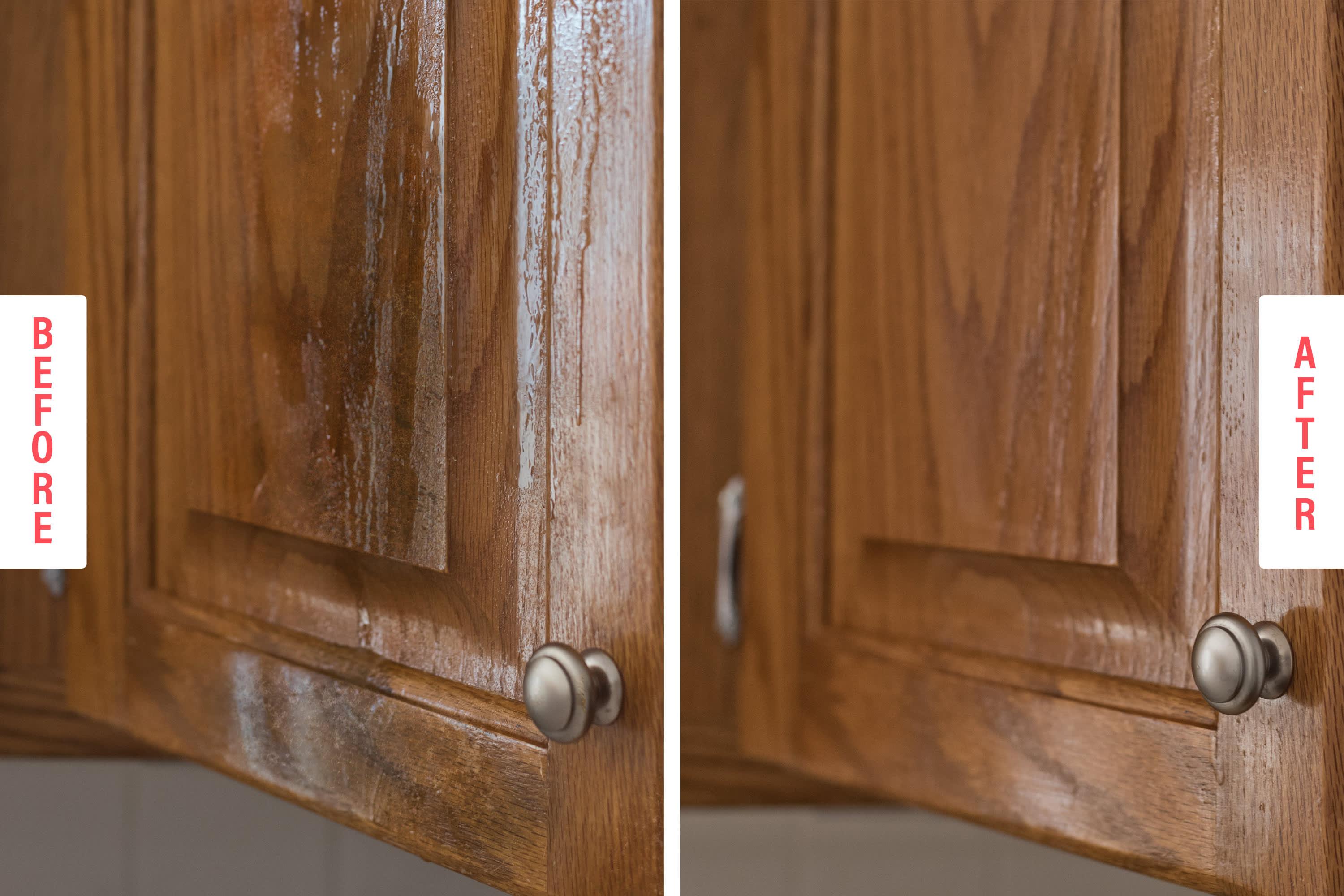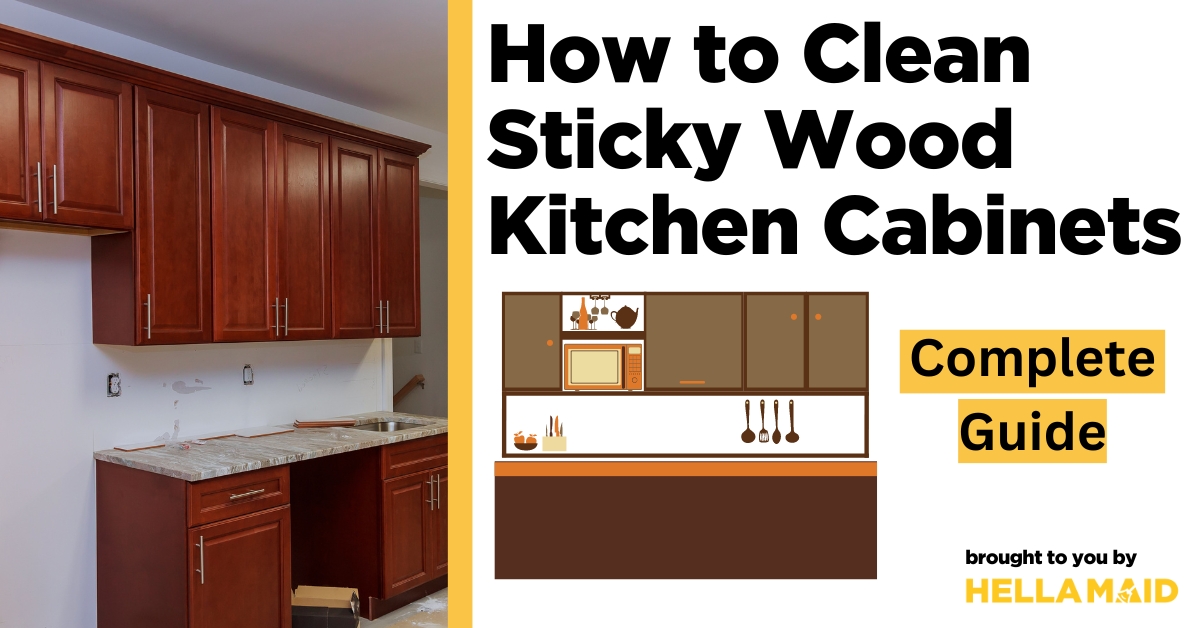Causes of Sticky Residue on Kitchen Cabinets

Sticky residue on kitchen cabinets is a common problem that can be caused by a variety of factors. It can be unsightly and difficult to remove, but understanding the causes can help you prevent it from happening in the first place.
Spills
Spills are a common cause of sticky residue on kitchen cabinets. Foods and beverages can easily splatter or drip onto cabinet surfaces, leaving behind a sticky mess. Examples of common spills that can cause sticky residue include:
- Syrup
- Honey
- Juice
- Soda
- Sauces
Grease Buildup
Grease from cooking can also contribute to sticky residue on kitchen cabinets. When food is cooked, grease particles can become airborne and settle on nearby surfaces, including cabinets. Over time, this grease can accumulate and create a sticky film.
Product Residue, Kitchen cabinets sticky residue
Certain products used in the kitchen can also leave behind sticky residue on cabinets. These products include:
- Cooking sprays
- Cleaning products
- Adhesives
Cooking sprays, such as non-stick sprays, are often used to prevent food from sticking to cookware. However, they can also leave a residue on cabinet surfaces. Cleaning products, especially those containing oils or waxes, can also contribute to sticky residue. Adhesives, such as those used to attach cabinet hardware or to repair damage, can also leave behind a sticky residue.
Cabinet Material
The material used for kitchen cabinets can also influence how easily sticky residue builds up. Wood cabinets are more porous than other materials, making them more susceptible to absorbing spills and grease. Laminate cabinets are more resistant to stains and spills, but they can still be affected by sticky residue. Painted cabinets can also be susceptible to sticky residue, especially if the paint is not properly sealed.
Cleaning Sticky Residue from Kitchen Cabinets: Kitchen Cabinets Sticky Residue

Tackling sticky residue on your kitchen cabinets can feel like a daunting task, but with the right approach, it’s manageable. The key is understanding the type of residue and the material of your cabinets. This guide will walk you through various methods and solutions for effectively removing stubborn stickiness.
Cleaning Methods for Sticky Residue
Knowing the type of sticky residue and the material of your cabinets is crucial for selecting the appropriate cleaning method. Here are some commonly encountered sticky residues and the best ways to address them:
- Food Spills: These are often easier to remove with a damp cloth and mild dish soap. For stubborn spills, you can use a baking soda paste (mix baking soda with water to form a paste) or a vinegar solution (mix equal parts vinegar and water).
- Grease: Grease can be tackled using a degreaser, a mixture of baking soda and water, or a commercial cleaner specifically designed for grease.
- Paint: Removing paint requires careful attention to avoid damaging the cabinet surface. A paint thinner or a specialized paint remover might be necessary, but always test a small, inconspicuous area first.
- Glue: Glue removal depends on the type of glue. For water-based glues, a damp cloth and mild soap usually suffice. For stronger adhesives, a commercial glue remover or a combination of baking soda and vinegar might be necessary.
- Tape: Tape residue can be removed with a combination of rubbing alcohol and a soft cloth. You can also use a hairdryer to soften the adhesive before gently peeling it off.
Cleaning Tools and Solutions
The tools and cleaning solutions you choose will depend on the type of sticky residue and the material of your cabinets. Here are some commonly used options:
- Microfiber cloth: This is a versatile cleaning tool that effectively absorbs sticky residue and cleans without scratching surfaces.
- Soft-bristled brush: A soft-bristled brush can help loosen sticky residue before wiping it away.
- Plastic scraper: For stubborn residue, a plastic scraper can be used to gently scrape off the sticky substance.
- Baking soda: Baking soda is a natural abrasive that can help loosen sticky residue. Mix baking soda with water to form a paste and apply it to the affected area.
- Vinegar: Vinegar is a natural cleaner that can help dissolve sticky residue. Mix equal parts vinegar and water and apply it to the affected area.
- Dish soap: Mild dish soap can effectively remove sticky residue from most surfaces.
- Commercial cleaners: There are various commercial cleaners available that are specifically designed for removing sticky residue. Always read the instructions carefully and test a small area first.
Effectiveness of Cleaning Methods
The effectiveness of different cleaning methods varies depending on the type of sticky residue and the material of your cabinets. Here is a table comparing the effectiveness of some common cleaning methods for different types of sticky residue:
| Cleaning Method | Food Spills | Grease | Paint | Glue | Tape | Damp Cloth and Dish Soap | Effective | Moderately Effective | Not Effective | Moderately Effective | Not Effective | Baking Soda Paste | Effective | Effective | Not Effective | Moderately Effective | Not Effective | Vinegar Solution | Effective | Moderately Effective | Not Effective | Moderately Effective | Not Effective | Commercial Cleaners | Effective | Effective | Effective | Effective | Effective |
|---|
Note: This table is a general guide. The effectiveness of different cleaning methods may vary depending on the specific type of residue and the material of your cabinets. Always test a small, inconspicuous area first before applying any cleaning solution to the entire surface.
Preventing Sticky Residue on Kitchen Cabinets

The best defense against sticky residue on kitchen cabinets is a proactive approach. By adopting preventative measures, you can significantly reduce the chances of sticky buildup and keep your cabinets looking their best.
Using Drip Trays and Wiping Spills Immediately
Using drip trays under appliances like coffee makers, toasters, and blenders can prevent spills from dripping onto cabinets. Placing a drip tray beneath these appliances creates a barrier that catches spills, minimizing the risk of sticky residue forming on your cabinets. Similarly, wiping spills immediately is crucial. The longer a spill sits on the surface, the more likely it is to become sticky and difficult to remove.
Storing Products Properly
Storing products properly plays a significant role in preventing sticky residue. Keeping food items in airtight containers prevents spills and messes. For example, storing sugary drinks or sauces in sealed containers helps prevent spills that could lead to sticky residue.
Protective Coatings or Sealants
Applying a protective coating or sealant to your cabinets can provide an extra layer of defense against sticky residue. These coatings create a barrier that repels spills and makes cleaning easier. For example, polyurethane coatings are commonly used on kitchen cabinets to protect them from spills, stains, and scratches.
Choosing Cleaning Products
Selecting the right cleaning products is essential for preventing sticky residue. Products containing harsh chemicals can leave behind a sticky residue, even after cleaning. Consider using cleaning products with natural ingredients, such as vinegar or baking soda, which are effective at cleaning without leaving behind a sticky residue.
Kitchen cabinets sticky residue – Sticky residue on your kitchen cabinets can be a real eyesore, making them look dull and neglected. But fear not! There are amazing cleaning solutions out there to tackle even the toughest grime. For painted cabinets, a gentle yet effective cleaner is key.
Check out this article on the best cleaner for painted cabinets to find the perfect solution to restore your cabinets to their former glory. Once you’ve tackled the sticky residue, your kitchen will feel fresh and inviting again.
That sticky residue on your kitchen cabinets can be a real pain! It’s tough to get rid of and can make your kitchen look messy. If the damage is extensive, you might be wondering if your homeowners insurance could cover replacing the cabinets.
While insurance policies vary, it’s always worth checking to see what’s covered. After all, a clean, fresh kitchen is a happy kitchen!
